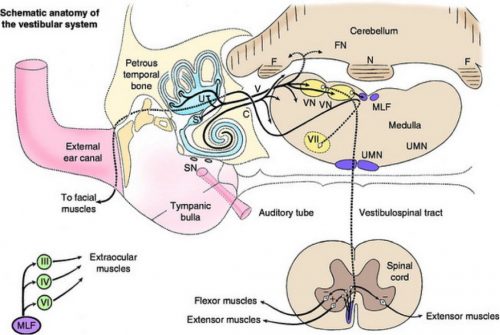Canine vestibular syndrome:
https://www.vetinfo.com/canine-vestibular-syndrome-symptoms.html
The canine vestibular system is essential for keeping the normal position and orientation of the pet. The vestibular system is linked to the brain and sends signals, letting the brain know when the dog is moving, so that balance is kept. The canine vestibular syndrome will manifest through lack of balance, which will cause confusion in the pet.
The canine vestibular system:
The canine vestibular system is linked to the brain and sends a signal to inform the brain when the dog changes position, spins or is in motion. The vestibular system is located in the inner ear canal and communicates with the brain through numerous small nerves. Consequently, a healthy ear canal is essential in maintaining the canine vestibular system healthy. If the vestibular system is affected, the dog’s brain will not get suitable signals and the dog may seem to lose his balance and will be confused.

Vestibular syndrome:
The vestibular syndrome can originate in the inner ear (the inner ear is damaged and causes the peripheral vestibular syndrome) or in the brain (there is a problem in the brain causing the central vestibular disease). Regardless of the origin of the disease, the dog will display the same symptoms.
Causes of vestibular syndrome:
The vestibular syndrome can have various causes including:
– Brain trauma or damage
– Tumors located in the brain of inner ear
– Ear infections, which may be due to mites that are present in the ear
– Severe poisoning
– Inflammation of the brain
– No known causes
Symptoms of canine vestibular syndrome:
A dog affected by the vestibular symptoms will display various symptoms. More commonly, dogs will experience dizziness, confusion and lack of coordination, but you may also notice the following symptoms:
– Frequent collapse, due to lack of coordination
– The head may be tilted on one side
– Frequent head shaking
– Spinning and rolling
– Rapid eye movement, but the eyes will be opened
– Dilated pupils
– Inability to jump over things, stumbling on objects
– Uncoordinated walk
– Vomiting
– Seizures (if the brain is affected)
The symptoms occur without any other warning signs, so the disease has a sudden onset. These symptoms may also be experienced if the dog is affected by poisoning or is in shock. However, the symptoms are severe, so you need to get veterinary help as soon as possible. To prevent injuries, you should place your pet in a secured area with soft pillows, so he won’t fall and get injured.
Vestibular syndrome diagnosis:
The vet will consult the dog to determine if he is not affected by other diseases that show similar symptoms. The vet will take a look at the dog’s ear canals and perform a neurological exam to diagnose the vestibular syndrome.
Treatment options:
The vestibular syndrome can be treated by managing the diseases that cause the vestibular system dysfunction. If the disease has no known causes, the dog should get medication to control the symptoms and the dizziness.
